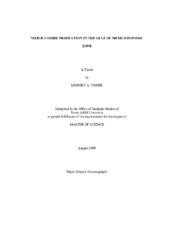| dc.description.abstract | The Gulf of Mexico hypoxic zone is created by strong persistent water
stratification and nutrient loading from the Mississippi River which fuels primary
production and bacterial decomposition. The Texas-Louisiana shelf becomes
seasonally oxygen depleted and hypoxia (O2 less than or equal to 1.4 ml l-1) occurs. Low oxygen
environments are conducive for the microbial production of nitrous oxide (N2O), a
powerful greenhouse gas found in the atmosphere in trace amounts (319 ppbv).
Highly productive coastal areas contribute 61% of the total oceanic N2O
production and currently global sources exceed sinks.
This study is the first characterization of N2O produced in the Gulf of
Mexico hypoxic zone. Because of enhanced microbial activity and oxygen
deficiency, it is hypothesized that the Gulf of Mexico hypoxic zone is a source of
N2O to the atmosphere. Seasonal measurements of N2O were made during three
research cruises in the Northern Gulf of Mexico (Sept. 2007, April 2008, and July
2008). Water column N2O profiles were constructed from stations sampled over
time, and bottom and surface samples were collected from several sites in the hypoxic zone. These measurements were used to calculate atmospheric flux of
N2O.
The Gulf of Mexico hypoxic zone was a source of N2O to the atmosphere,
and N2O production was highest during times of seasonal hypoxia. N2O was
positively correlated with temperature and salinity, and negatively correlated with
oxygen concentration. Atmospheric fluxes ranged from -11.27 to 153.22 umol m-2
d-1. High accumulations of N2O in the water column (up to 2878 % saturated)
were associated with remineralization of organic matter at the base of the
pycnocline and oxycline. Seasonal hypoxia created a source of N2O to the
atmosphere (up to 2.66 x 10-3 Tg N2O for the month of September 2007), but there
was a slight sink during April 2008 when hypoxia did not occur. Large fluxes of
N2O during the 3 to 5 month hypoxic period may not be counterbalanced by a 7 to
9 month sink period indicating the Gulf of Mexico hypoxic zone may be a net
source of N2O to the atmosphere. | en |


